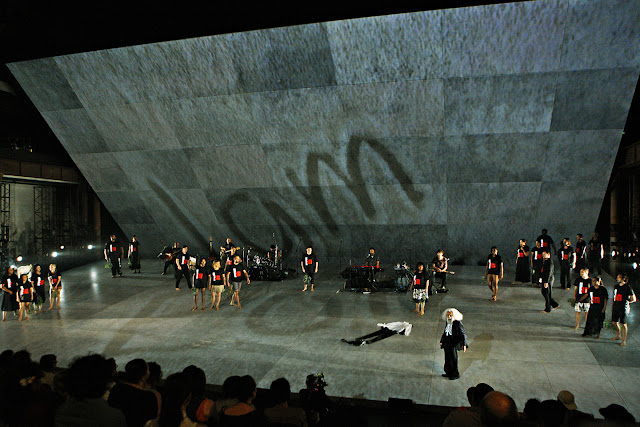Reviewed by Frank McKone
January 21
Photos by Heidrun Lohr
Top: Effie Nkrumah
Below:Meyne Wyatt
If you think that living down and out among scaffolding on a construction site might be less than exciting, then avoid Buried City for it is a kind of faithful representation described by the author as follows:
What strikes me about Alicia Talbot’s work is that it is not about presenting a metaphor on stage, or at least it’s not about seeing theatre as a metaphor that transforms the performance into a poetic representation. It feels much fresher, much more contemporary, in that what is aimed for is the presentation of a new form of theatre based on ritual everydayness.
Well, the director has succeeded in this aim, but unfortunately this is not exactly a new form of theatre. Eugene O’Neill did it in The Iceman Cometh (1939) and even Beckett’s Waiting for Godot with Ian McKellen and company, which we saw in Sydney in 2010, more powerfully showed life getting nowhere. It’s just a bit of a pity that director Sean Mathias said Godot is “like an incredible poem or a very beautiful piece of music”, and this is what makes it effective over the generations of theatre goers. Iceman was rather more like Buried City, in that nothing happens in an apparently naturalistic scene, but O’Neill knew how to make us feel the awful necessity of self-destructive ritual which the characters play out, which also becomes a picture not just of a few drunks in a bar but of America as a nation still in the Great Depression.
Cortese and Talbot show up their artistic problem in describing their work as “rather like a living film set with no close ups”, while also writing about revealing “how as human beings we build temporary bridges and alliances in an effort to have a meaningful purpose to how we live our lives.” In fact there are some “close ups”: the two that work theatrically are Aboriginal actor Meyne Wyatt and Effie Nkrumah, of Ghanaian descent, particularly in their clash over belief in their different ‘spirits’. Otherwise, the other characters are predictable, even though much of the action is unfathomable because there is no development of motivation.
The result for me was that I could not see or feel any sense of ritual in this ‘everydayness’, nor much reality. At the end it was difficult for me to know how to respond. I felt I should applaud the actors for their work – and they did manage to achieve some moments of dramatic tension – but this was despite the script which really didn’t help them. They did come back for a second brief curtain call, but I noticed others in the audience also hesitating about clapping, perhaps from the same kind of confusion as I felt.
I guess the intentions of Urban Theatre Projects are worthwhile in principle – to expose the terrible empty space of living without purpose, and I suppose to show that this is a dreadful feature of our society – but this attempt is not ‘much fresher, much more contemporary’ theatre. In her notes, Alicia Talbot writes The text has been stripped of its conventional theatrical content…. There’s no backstory and almost no personal information provided about any of the characters, no classic plot to speak of….
Perhaps then I am the problem: maybe I am just not fresh and contemporary enough for this play.
© Frank McKone, Canberra












